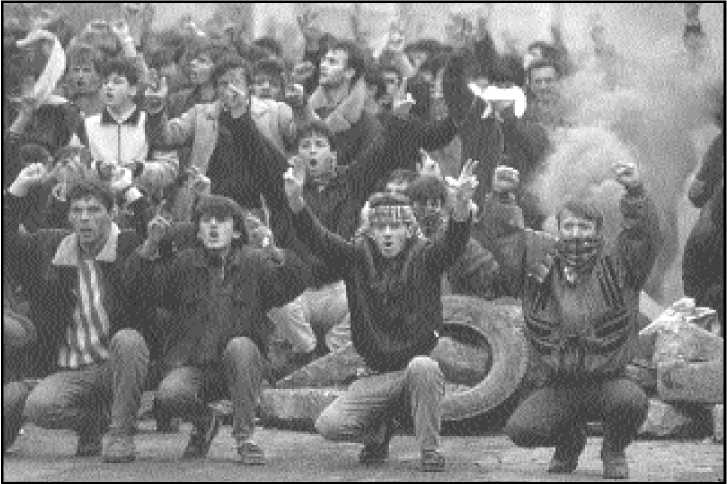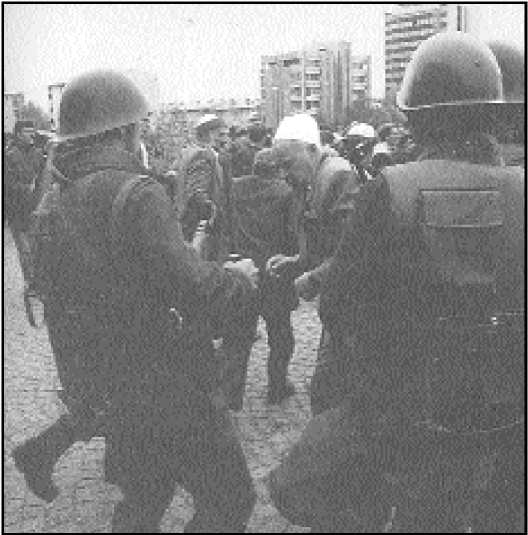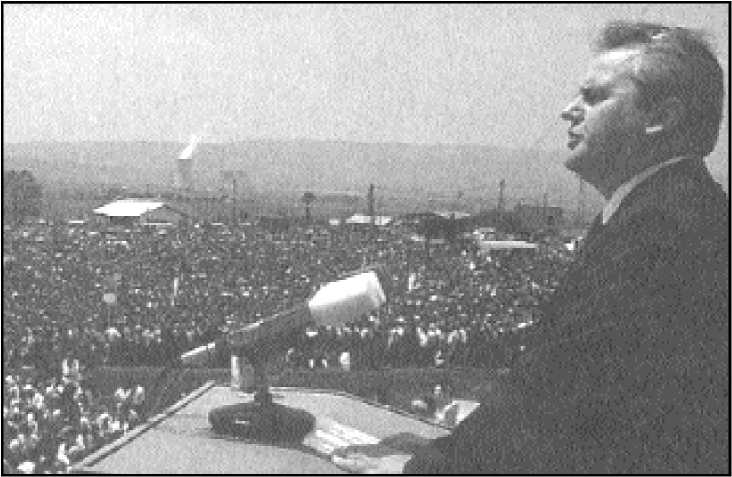
Demonstration in Pristina, 1990
Paul D’Amato Archive | ETOL Main Page
From International Socialist Review, Issue 7, Spring 1999, pp.6–8.
Downloaded with thanks from the ISR Archive Website.
Marked up by Einde O’ Callaghan for the Encyclopaedia of Trotskyism On-Line (ETOL).
IN DEMONSTRATIONS across the world, Serbian nationalists have chanted the slogan “Kosovo is Serbia,” justifying the Serbian military operations in Kosovo as merely a struggle against “terrorism” to protect its national heritage. Clinton’s bombing, touted as an effort to save the Kosovar Albanians from Serbia’s wrath, has merely given cover for a worsening of Serbia’s attacks in Kosovo. It has provided grist for Serbia’s most right-wing nationalists, including people like the fascist leader Vojislav Seselj, who want to “cleanse” Kosovo of all Albanians.
For Serbian nationalists, Kosovo is considered the “cradle” of the Serb nation. They stake a cultural claim on the territory of Kosovo by referring to the 1389 battle of Kosovo Polje, when Serb soldiers made a stand against the expanding Ottoman empire. Never mind that in this battle Serbs and Albanians fought side by side against the Ottoman Empire. The myth is just that – a myth designed to stir up irrational passions.
The reality is that Kosovar Albanians – who constitute 90 percent of the population of Kosovo – have long been an oppressed minority within Serbia. Police repression and attempts to deny Albanian speakers national rights have driven Kosovars toward demands for independence from Serbia.
The source of tensions in Kosovo – and the Balkans as a whole – is the imperialist carve-up of the region. There we re two Balkan Wars in 1912 and 1913, the First World War and the Second World War, which all saw the redrawing of boundaries to fit the needs of imperialism, not the desires of the peoples of the region.
At the end of the two Balkan Wars, the leading powers sat down and dictated a peace agreement dividing the areas populated by Albanians – handing Kosovo to Serbia – an arrangement that was reconfirmed after the First World War. More than half the Albanian-speaking population was left out of the new Albanian state.
“The fairness or otherwise,” writes one historian, “of the allocation of Albania’s frontiers can be judged by a speech made by Sir Edward Grey to the House of Commons on 12 August, 1913, in which he openly stated that the basic objective of the agreement on the borders was to satisfy the Great Powers.” One observer called Albania’s division “an ulcer poisoning European system.” [1]

Demonstration in Pristina, 1990 |
In 1921, the Kosovars, seeking a peaceful road to independence from Serbia, petitioned the League of Nations, the United Nations of its day. They begged for reunion with Albania. The League refused.
The postwar Serb-dominated Yugoslav state sought to repress any attempt by the Kosovar Albanians to resist their forcible retention within the borders of Serbia. It denied Albanians the right to use their own language in official circles or in cultural activities. All schooling was conducted in Serbo-Croat. In the interwar years, Serbia sent thousands of loyal Serb colonists to Kosovo in order to secure its borders, often settling them on land expropriated from Albanians who, lacking paper titles, could not prove ownership. At the same time, the Yugoslav government officially encouraged Albanians to emigrate. In the mid-1930s, Yugoslavia negotiated a deal to ship 200,000 Albanians to Turkey. To promote the exodus, Belgrade legally restricted Albanians in some counties of Kosovo to landholdings too small to survive on.
After the Second World War, Josep Broz Tito’s victorious partisan movement established a new Yugoslavia, this time not Serb dominated. Tito built the new state on the basis of a series of checks and balances between the various republics, ruled from above by a tightly centralized bureaucracy which did not allow one republic to dominate another. But there was one exception to this policy: In order to pre vent a “greater Serbian” domination of the new state, Tito’s ruling Communist Party created new republics that contained either Serb majorities or large Serbian minorities – Montenegro, Bosnia-Herzegovina and Macedonia. In order to win Serbian acceptance of the new arrangement, Kosovo was given the status of a province of Serbia with only limited regional autonomy. During the resistance, Tito had promised the Kosovar Albanians the right to rejoin Albania as part of a proposed federation of Balkan states. After the war’s end, he reneged on his promise.
Kosovar Albanians – and in particular the upper strata of bureaucrats and managers – saw Serbia’s tutelage over Kosovo as denying the province of its rightful status as a federal republic like the others. They reasoned that Kosovo, with an Albanian majority that constituted 90 percent of the population, deserved that status as much as Bosnia or Macedonia, whose populations were even more mixed between different national groups. But Belgrade ruthlessly suppressed any discussion about Kosovo’s status.
In 1974, Tito promulgated a new constitution that granted greater autonomy to the republics. Partly in response to the growth of student unrest in Kosovo in the late 1960s, the constitution granted Kosovo the rights of a full republic in all but one respect: Albanians were defined as a “national minority” in Yugoslavia, but not as a nation. Therefore they did not have, like the other republics (at least theoretically), the right to secession. Nevertheless, the change created an awakening of national life among Kosovar Albanians. With fuller local control, the provincial leadership established a kind of affirmative action policy in Kosovo that “Albanianized” the province by promoting Albanian culture. Provincial leaders built a new university in Pristina , and a whole new stratum of Albanian state and party officials, industrial managers, teachers, policemen and radio and television personalities appeared. The number of people in higher education mushroomed, in part to soak up the large numbers of unemployed young people in what was the poorest region of Yugoslavia. The state also designated Kosovo as an underdeveloped region, allotting the region’s leaders additional investment funds and easy credit.

Serbian cops break up |
One result of these changes was the mass migration of peasants from rural areas and the creation for the first time of a sizable working class in Kosovo.
Mass student demonstrations, initially over poor living conditions, spilled over into a province-wide demonstration demanding republican status in 1981. The Yugoslav army immediately declared marshal [sic!] law and repressed the revolt with tanks and armored personnel carriers. This marked the beginning of the end of Kosovar autonomy – and the resurgence of Serbian nationalism.
The changes in the fortunes of Kosovar Albanians after 1974 created a sense of unease among the minority Serb population in Kosovo, who constituted a declining 17 percent of the population, and had enjoyed for many years a dominant status in the region. That unease was exploited by Serbian nationalists who, in the late 1980s, began to whip up a campaign of anti-Albanian racism.
In the face of a spiralling economic crisis and mass strikes in the late 1980s, Slobodan Milosevic made a bid for power. Though no nationalist, he realized that by aligning himself with Serbian nationalists in their attack on Kosovo, he could divert class anger in Serbia and establish firm control over the state.
Branka Magas describes the nature of the campaign against Kosovar Albanians:
The official media joined in, sparing no tactics. One of the most shameful was to invent daily stories about the rape of Serb women – despite all official statistics showing the absurdity of such racist fables. Another was to claim that the high Albanian birthrate was part of a nationalist plot and should be countered by discriminatory state measures. This hysterical campaign was effective ... Factories started to be built in Kosovo for Serbs only, Albanian families were evicted from Serb villages, sale of Serb-owned land to Albanians was prohibited, rape declared a political crime. [2]
Milosevic stage-managed mass nationalist rallies in Kosovo and other parts of Serbia where demonstrators shouted racist slogans like, “Let us go, brothers and sisters, to attack Kosovo!”
As state capitalism fell apart around the world in 1989 and economic crisis brought the republics to the verge of collapse, Milosevic revoked Kosovo’s autonomy and removed its party leaders.
The effect of the repression was to cause the Albanian population to close ranks. The Trepca miners led the way in February 1989, occupying the mine and going on an eight-day hunger strike. Schools, markets and shops closed as Kosovars poured out to support the miners in what amounted to a near rebellion. That was followed by a general strike in 1990. The initial demand of the movement was not independence, but merely that Kosovar Albanian leaders replaced by Milosevic be reinstated, and that there be a free and open dialogue on the status of Kosovo. Ordinary Kosovar Albanians we re driven to support independence in reaction to the massive repression from Belgrade.

Yugoslav President Milosevic speaks |
In response, Milosevic sent thousands of Serbian police to take control of Kosovo. Ethnic Albanians found themselves living under apartheid – forced to use separate bars, restaurants, and public transportation. Thousands of Albanians we re fire d from their jobs. The education system was shut down. Living standards were driven down: per capita income fell to around $500 per year. Prewar unemployment among Kosovars was 85 percent. Public contact with Serbs was frowned on. Police and army units now maintained order with armored transports and machine guns.
After Serbia took over Kosovo, the Democratic League of Kosovo (LDK), led by a moderate nationalist, Ibrahim Rugova, declared Kosovo an independent state, with Rugova as head of an Albanian “shadow” government. Ignoring the Serbian state, the LDK set up a parallel education, health care and taxation system. The new government urged a policy of peaceful resistance. In a 1991 referendum, 98.7 percent of Kosovars voted for independence from Serbia on the eve of the disintegration of Yugoslavia.
This has led to disastrous results. To escape Serbian oppression of the inter-war period, for example, the Albanians became wards of Italian and German fascism. Today, the KLA in practice is becoming a subordinate junior partner to the U.S., which is using the plight of the Kosovar refugees to advance its own war aims. The U.S. does not even pretend to defend the right of the Kosovars or other peoples of the Balkans to determine their own fate. It opposes their right to self-determination as a threat to the status quo it wants to impose as the dominant power in the Balkans and Europe. Kosovo is the cover story for the U.S. to impose its “peace” as the policeman and protector of European stability.
No amount of sympathy for the oppression of the Kosovar Albanians can justify a new war of American domination and the extension of its empire. In the event of a NATO victory, a number of outcomes are possible – the partition of Kosovo, or the creation of a NATO protectorate in Kosovo. If that happens, Albanians will find a new colonial master – in the uniform of the U.S. military officer.
1. Miranda Vickers, Between Serb and Albanian: A History of Kosovo (Columbia University, 1998).
2. Branka Magas, The Destruction of Yugoslavia: Tracking the Break-Up 1980–92 (Verso Press, 1993).
Paul D’Amato Archive | ETOL Main Page
Last updated: 24 August 2021